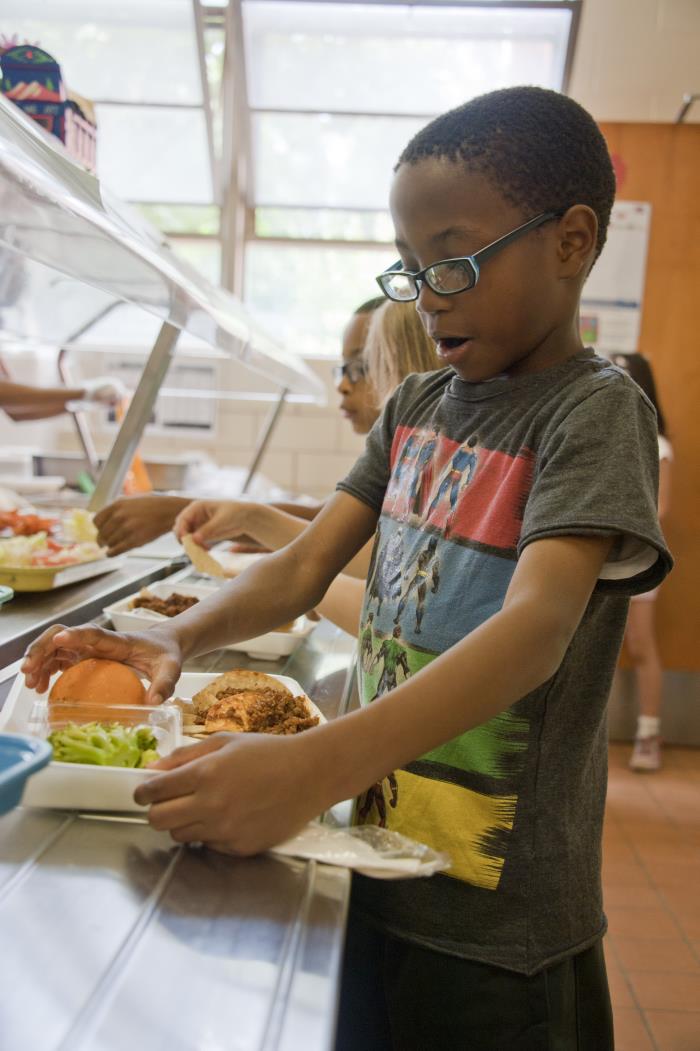Our Impact

NPI's research provides influential evidence that shapes federal, state and local nutrition programs. Since 2014, NPI has contributed to several program and policy wins!
Read about our impact below, and in this news story celebrating our 10-year anniversary.
School Meals for All
NPI demonstrated that school meals improve the overall diet quality of students and that providing universal school meals increases student participation.a California became the first state in the nation to permanently adopt school breakfast and lunch at no charge, providing access to better nutrition for over 6 million K-12 students annually.
Chips, Soda and Profits in Schools
NPI showed that schools would not lose money if they stopped selling chips and soda. California became the first state to pass legislation prohibiting sales of these foods in schools.b This law improves the nutrition of over 6 million children in California every year.
Cooking School Meals – Can We Afford Them?
NPI demonstrated that cooking from scratch in school kitchens doesn’t cost more than selling pre-packaged foods, and that kids prefer freshly prepared meals.c This has contributed to the USDA funding $30 million for school kitchen equipment in fiscal year 2018 alone.
More Recess Time for Children in California Schools
NPI research showed that many California elementary schools do not meet recommendations to provide students more than 20 minutes per day of recess, which is critical to support their physical activity and physical fitness. California state policy now requires all students have access to 30-minutes of recess each day beginning in the 2024-2025 school year.
Healthy Women, Infants and Children
NPI research showed some of the health benefits of providing healthier foods in the Special Supplemental Nutrition Program for Women, Infants and Children—commonly known as WIC—including increased funding for fruit and vegetable purchases.d Over 1 million women and children receive WIC benefits annually in California – reaching over half of all infants born in the state and one-quarter of children between the ages of 1 and 5 years old.
Healthier Foods and Beverages in Child Care and the Law
NPI research showed that childcare providers who participate in the federal Child and Adult Care Food Program—also known as CACFP—provide better nutrition than those that do not.e NPI provided the evidence to pass California’s Healthy Beverages in Childcare law, which is among the most comprehensive child care beverage policies in the nation.f Nearly 2 million preschoolers in the state now get only healthy beverages while in childcare and the state is engaged in efforts to increase CACFP participation.
Safe Tap Water in California Schools and Child Care Centers
NPI showed that increasing water promotion and access can improve child weight status, yet some school drinking water sources have too much lead.g As a result, lead testing and remediation in California schools and childcare settings is required. California also leads the nation with both SNAP-Ed and schools required to teach about healthy hydration.
Making Food Pantries Healthier
NPI research showed that clients at food pantries would rather get healthy foods instead of chips, candies and soda.h Over 1,800 food bank staff have taken NPI’s online training to improve food bank nutrition policies leading to healthier foods and beverages distributed by California food banks and pantries to food insecure people.
Improving Student Food Security on University of California Campuses
NPI research showed that 4-in-10 University of California students struggle with food insecurity.i This led to the creation of Basic Needs Campus Centers on all 10 UC campuses to combat food insecurity at one of the largest university systems in the United States.
Healthy Vending Options at the University of California
NPI showed that University of California campuses with healthy vending options achieved greater sales of healthy snacks and drinks. UC now has a healthy vending policy based on evidence-based guidelines, providing more than 280,000 students and 227,000 faculty and staff access to healthier vending options on UC campuses.
Food Waste – Let’s Stop It
As part of ANR’s public value of safeguarding healthy and abundant food, NPI led the first California Food Waste Prevention Week in 2017 to raise awareness about food waste, a campaign which received more than 54 million online unique page views.
Increasing Locally Grown Produce in State Prisons
NPI collaborated to expand the purchasing of California-grown produce in prisons operated by the California Department of Corrections and Rehabilitations, the single largest purchaser of food in the state. More local produce is now served in state prisons through a Farm to Corrections Harvest of the Month program, benefiting people who are incarcerated, staff, and CA growers and distributors.
Improving Supplemental Nutrition Assistance Program Education
NPI showed that comprehensive, more intensive Supplemental Nutrition Assistance Program Education interventions—known nationally SNAP-Ed and CalFresh Healthy Living in California—are associated with better fitness and diet-related outcomes in children, leading to more effective healthy eating and active living efforts that can reach up to one-third of Californians.
Expanding CalFresh Benefits to Farmers Markets
NPI demonstrated that dollar-for dollar match incentive programs for CalFresh—known nationally as SNAP—participants at farmers’ markets help families purchase additional California-grown fruits and vegetables. California legislators have provided millions in funding to continue CalFresh match benefits.
References:
a. [1] Au LE, Gurzo K, Gosliner W, Webb KL, Crawford PB, Ritchie LD. Eating school meals daily is associated with healthier dietary intakes. J Acad Nutr Diet. 2018;118:1474-1481. https://doi.org/10.1016/j.jand.2018.01.010 [2] Zuercher MD, Cohen JFW, Hecht CE, Hecht K, Ritchie LD, Gosliner W. Providing School Meals to All Students Free of Charge During the COVID-19 Pandemic and Beyond: Challenges and Benefits Reported by School Foodservice Professionals in California. 2022;14:3855. https://doi.org/10.3390/nu14183855
b. [1] Peart T, Kao J, Crawford PB, Samuels SE, Craypo L, Woodward-Lopez G. Does competitive food and beverage legislation hurt meal participation or revenues in high schools? Child Obes. 2012;8(4):339-46. https://doi.org/10.1089/chi.2012.0009 [2] California SB-965, 2005-2006. https://leginfo.legislature.ca.gov/faces/billNavClient.xhtml?bill_id=200520060SB965 [3] California SB-12, 2005-2006 https://leginfo.legislature.ca.gov/faces/billNavClient.xhtml?bill_id=200520060SB12
c. [1] Woodward-Lopez G, Kao J, Kiesel K, Lewis Miller M, Boyle M, Drago-Ferguson S, Braff-Guajardo E, Crawford P. Is scratch-cooking a cost-effective way to prepare healthy school meals with US Department of Agriculture foods? J Acad Nutr Diet. 2014 Sep;114(9):1349-58. https://doi.org/10.1016/j.jand.2014.05.002.
d. [1] May L, Borger C, Weinfield N, MacAllum C, Montaquila J, McNutt S, Whaley S, Ritchie L, Sallack L. WIC Infant and Toddler Feeding Practices Study - 2: Infant Year Report. Alexandria, VA: US Department of Agriculture, Food and Nutrition Service. April 2016. https://www.fns.usda.gov/wic/itfps-2-infant-year-report [2] Borger C, Weinfield N, Zimmerman T, MacAllum C, DeMatteis J, Whaley S, Ritchie L, Sallack L, Au L, Jenkins F, May L. WIC Infant and Toddler Feeding Practices Study-2: Second Year Report. US Department of Agriculture, Food and Nutrition Service. April 2018. https://www.fns.usda.gov/wic/itfps-2-second-year-report [3] Au LE, Whaley S, Rosen NJ, Meza M, Ritchie LD. Online and In-Person Nutrition Education Improves Breakfast Knowledge, Attitudes, and Behaviors: A Randomized Trial of Participants in the Special Supplemental Nutrition Program for Women, Infants, and Children. J Acad Nutr Diet. 2016 Mar;116(3):490-500. https://doi.org/10.1016/j.jand.2015.10.012 [4] Ritchie LD, Whaley SE, Spector P, Gomez J, Crawford P. Favorable impact of nutrition education on WIC families. J Nutr Ed Behav. 2010;42:S2-S10. https://doi.org/10.1016/j.jneb.2010.02.014 [5] Fung EB, Ritchie LD, Walker BH, Gildengorin G, Crawford PB. Randomized controlled trial to examine the impact of providing yogurt to women enrolled in WIC. J Nutr Ed Behav. 2010;42:S22-S29. https://doi.org/10.1016/j.jneb.2010.02.009 [6] Whaley SE, Ritchie LD, Spector P, Gomez J. Revised WIC food package improves diets of WIC families. J Nutr Ed Behav. 2012;44:204-9. https://doi.org/10.1016/j.jneb.2011.09.011 [7] Au LE, Whaley S, Gurzo K, Meza M, Ritchie LD. If you build it they will come: Satisfaction and utilization of WIC participants with online and traditional in-person nutrition education. J Nutr Ed Behav. 2016;48:336-42. https://doi.org/10.1016/j.jneb.2016.02.011 [8] Au LE, Whaley S, Rosen NJ, Meza M, Ritchie LD. Online and in-person group nutrition education reduces sodium intake: A randomized trial to assess knowledge, self-efficacy and behaviors in WIC participants. J Am Acad Nutr. 2017;117:1384-95 [9] Au LE, Gurzo K, Paolicelli C, Whaley SE, Weinfield NS, Ritchie LD. Diet quality of U.S. infants 7-24 months old in the WIC Infant and Toddler Feeding Practices Study-2. J Nutr. 2018;148:1786-93. https://doi.org/10.1093/jn/nxy192 [10] Au LE, Paolicelli C, Gurzo K, Ritchie LD, Whaley SE. Contribution of WIC-eligible foods to the overall diet of 13- and 24-month-old toddlers in the WIC Infant and Toddler Feeding Practices Study-2. J Acad Nutr Diet. 2019;119:435-448. https://doi.org/10.1016/j.jand.2018.11.001 [11] Anderson CE, Au LE, Yepez CE, Ritchie LD, Tsai MM, Whaley SE. Increased WIC Cash Value Benefit is associated with greater amount and diversity of redeemed fruits and vegetables among participating households. Curr Dev Nutr. 2023 Aug 3;7(9):101986. https://doi.org/10.1016/j.cdnut.2023.101986 [12] Ritchie L, Lee D, Felix C, Sallack L, Chauvenet C, Machel G, Whaley SE. Multi-State WIC Participant Survey: Cash Value Benefit Increase During COVID. The National WIC Association. UC ANR Nutrition Policy Institute. 1 March 2022. https://thewichub.org/multi-state-wic-participant-satisfaction-survey-cash-value-benefit-increasing-during-covid/ [13] Martinez CE, Ritchie LD, Lee DL, Tsai MM, Anderson CE, Whaley SE. California WIC Participants Report Favorable Impacts of the COVID-Related Increase to the WIC Cash Value Benefit. Int J Environ Res Public Health. 2022;19(17):10604. https://doi.org/10.3390/ijerph191710604 [14] Whaley SE, Anderson CE, Tsai MM, Yepez CE, Ritchie LD, Au LE. Increased WIC benefits for fruits and vegetables increases food security and satisfaction among California households with young children. J Acad Nutr Diet. 2023;123(10):1440-1448.e1 https://doi.org/10.1016/j.jand.2023.05.018
e. [1] Ritchie LD, Boyle M, Chandran K, Spector P, Whaley SE, James P, Samuels S, Hecht K, Crawford P. Participation in the child and adult care food program is associated with more nutritious foods and beverages in child care. Child Obes. 2012.8(3):224-9. https://doi.org/10.1089/chi.2011.0061 [2] Gurzo K, Lee DL, Ritchie K, Yoshida S, Homel Vitale E, Hecht K, Ritchie LD. Child Care Sites Participating in the Federal Child and Adult Care Food Program Provide More Nutritious Foods and Beverages. J Nutr Ed Behav. 2022;52(7):607-704. https://doi.org/10.1016/j.jneb.2020.02.009
f. [1] Ritchie LD, Sharma S, Gildengorin G, Yoshida S, Braff-Guajardo E, Crawford P. Policy improves what beverages are served to young children in child care. J Acad Nutr Diet. 2015 May;115(5):724-730. https://doi.org/10.1016/j.jand.2014.07.019 [2] Ritchie LD, Yoshida S, Sharma S, Patel A, Vitale EH, Hecht K. Drinking water in California child care sites before and after 2011-2012 beverage policy. Prev Chronic Dis. 2015;12:E89. https://doi.org/10.5888/pcd12.140548 [3] Lee DL, Gurzo K, Nhan LA, Homel Vitale E, Yoshida S, Hecht K, Ritchie LD. Status of Beverages Served to Young Children in Child Care After Implementation of California Policy 2012-2016. Prev Chronic Dis. 2022:17:E30. https://doi.org/10.5888/pcd17.190296
g. [1] Garvey KA, Edwards MA, Blacker LS, Hecht CE, Parks JL, Patel AI. A Comprehensive Examination of the Contaminants in Drinking Water in Public Schools in California, 2017-2022. Public Health Rep. 2023;333549231192471. https://doi.org/10.1177/00333549231192471 [2] Patel AI, Schmidt LA, McCulloch CE, Blacker LS, Cabana MD, Brindis CD, Ritchie LD. Effectiveness of a School Drinking Water Promotion and Access Program for Overweight Prevention. 2023; published online ahead of print. https://doi.org/10.1542/peds.2022-060021 [3] Cradock AL, Barrett JL, Poole MK, Flax CN, Vollmer L, Hecht C. Lead Concentrations in US School Drinking Water: Testing Programs, Prevalence, and Policy Opportunities, 2016-2018. Am J Public Health. 2022;122(S7):S679-S689, https://doi.org/10.2105/AJPH.2022.306961 [4] Cradock AL, Poole MK, Vollmer LY, Barrett JL, Flax CN, Hecht CA. State Policies on Testing Drinking Water for Lead in U.S. Schools. Research Brief. Durham, NC: Healthy Eating Research; January 2019. https://healthyeatingresearch.org/wp-content/uploads/2019/01/HER-Brief_State-Policies-on-Testing-Drinking-Water-for-Lead-in-U.S.-Schools-1.pdf
h. [1] Campbell E, Hudson H, Webb K, Crawford PB. Food Preferences of Users of the Emergency Food System. J Hunger Environ Nutr. 2011;6(2):179-187, https://doi.org/10.1080/19320248.2011.576589
i. [1] Martinez SM, Webb K, Frongillo EA, Ritchie LD. Food insecurity in California’s public university system: What are the risk factors? J Hunger Environ Nutr. 2018;13(1):1-18. https://doi.org/10.1080/19320248.2017.1374901 [2] Martinez SM, Frongillo EA, Leung C, Ritchie L. No food for thought: Food insecurity is related to poor mental health and lower academic performance among students in California's public university system. J Health Psychol. 2020;25(12):1930-1939. https://doi.org/10.1177/1359105318783028 [3] Martinez SM, Grandner MA, Nazmi A, Canedo ER, Ritchie LD. Pathways from Food Insecurity to Health Outcomes among California University Students. Nutrients. 2019;11(6):1419. https://doi.org/10.3390/nu11061419 [4] Martinez SM, Maynard K, Ritchie LD. University of California Global Food Initiative: Student Food Insecurity Study. July 2016. http://www.ucop.edu/global-food-initiative/best-practices/food-access-security/student-food-access-and-security-study.pdf
The Nutrition Policy Institute was honored for our 10 year anniversary with a Resolution from the California Legislature in 2024 by Nancy Skinner, 9th Senatorial District, and Mia Bonta, 18th Assembly District.



Image Credit: USDA FNS WIC

Image Credit: CDC/Amanda Mills


